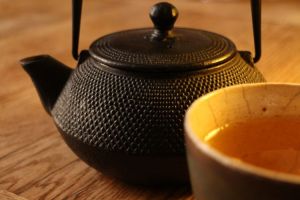
When it comes to Japanese tea culture, most people tend to think first of elaborate ceremonies, poetry, and all the philosophy typically embodied in chadō. And while these are essential components of the Japanese approach to tea, few realize that beneath the history and aesthetics lies a very pragmatic approach to the production of tea. The careful balance of cutting-edge technology with traditional methods, and an appreciation for efficiency, has done well to make Japanese teas some of the most common in the world.
Modern Japanese tea production owes much to the concept of kaizen, a term that was introduced to the business world in the aftermath of WWII. Kaizen, which roughly translates as “continuous improvement”, was conceived by William Deming and made famous by Toyota as a way of constant small innovation that, in the long-term, will help a business attain perfection.
Using kaizen, Japanese tea production is the ultimate in efficiency: from the harvest of one plant, you can get not only sencha, but also shincha, kukicha, bancha, hojicha, and genmaicha. Let’s take a look at all of these teas.
Sencha: The most common type of Japanese tea, accounting for roughly 80% of the country’s tea production. Sencha ranges in quality from top-end to ready-to-drink dust & fannings, and is produced throughout the growing season. After harvest, it is steamed to stop oxidation, rolled into thin needle shapes, and oven-dried.
Shincha: The very first yield of sencha, shincha is composed of young new leaves that are plucked early in spring before the main harvest begins. Shincha is prized among connoisseurs for its rarity, complex flavors, and freshness.
Bancha: Harvested from mid-June to September after sencha production is finished, bancha utilizes fuller, more mature leaves and sometimes stems to give it its characteristic notes of sweet hay and bold grassiness.
Kukicha: Kukicha is made from stems and leaf cuttings leftover from sencha production. It is more delicately flavored than sencha or bancha, with savory sesame notes.
Hojicha: This unique green tea is made of sencha or bancha leaves, sometimes blended with kukicha, that have been roasted at 200°F for several minutes. Roasting imparts a rich, sweet, and nutty flavor – along with a lower caffeine content that makes it perfect for the evenings.
Genmaicha: Originally a staple of fasting monks and the poor, genmaicha is sencha or bancha that has been blended with toasted brown rice, which gives it a wonderfully mellow quality and full body.
Kaizen approaches in Japanese industry have been a tremendous gift to tea drinkers, allowing aficionados the chance to enjoy the diverse range of flavors that come from a single plant. Have you tried sencha and all the teas derived from it yet? Which is your favorite?
By: Jen Coate









 Chinese history and traditions, which are thought to bring strength to the country as it undergoes rapid change and modernization. This focus on history brought puerh and puerh tea cakes to the top of the tea market. Not to lose ground, manufacturers of white and oolong teas began producing their own aged cakes to compete for the attention of the newly born middle class Chinese consumer. Using much the same technology as the puerh makers, these manufacturers are charting new territories in tea production, while still using the traditional methods.
Chinese history and traditions, which are thought to bring strength to the country as it undergoes rapid change and modernization. This focus on history brought puerh and puerh tea cakes to the top of the tea market. Not to lose ground, manufacturers of white and oolong teas began producing their own aged cakes to compete for the attention of the newly born middle class Chinese consumer. Using much the same technology as the puerh makers, these manufacturers are charting new territories in tea production, while still using the traditional methods.
 It’s amazing to see how fast coronavirus has changed everything. Across the country, Americans are settling into new social isolation routines, which can be difficult and frightening, especially for those of us who enjoy long conversations with friends and family over a pot of tea. But even though times are stressful, we at Dominion Tea want to remind you to take comfort in the little things that can make it all more bearable: a healthy walk outside, a phone conversation with a loved one, or – of course – a comforting cup of your favorite tea.
It’s amazing to see how fast coronavirus has changed everything. Across the country, Americans are settling into new social isolation routines, which can be difficult and frightening, especially for those of us who enjoy long conversations with friends and family over a pot of tea. But even though times are stressful, we at Dominion Tea want to remind you to take comfort in the little things that can make it all more bearable: a healthy walk outside, a phone conversation with a loved one, or – of course – a comforting cup of your favorite tea.